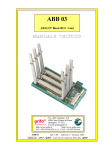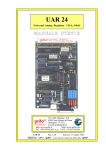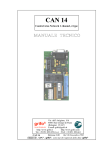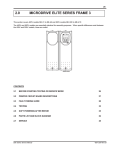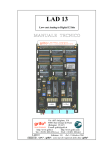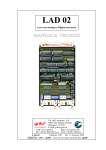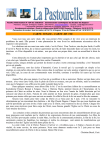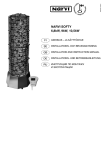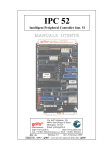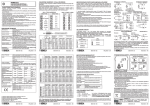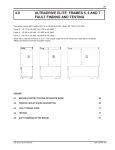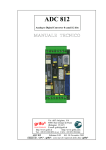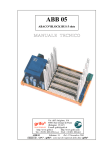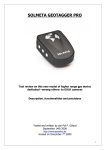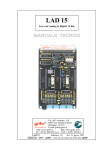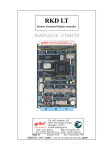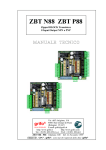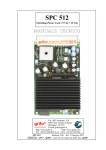Download COP-UAR 24-5.20-UK
Transcript
UAR 24 Universal Analog Regulator with 2 D/A, 4 Relays USER MANUAL Via dell' Artigiano, 8/6 40016 San Giorgio di Piano ® (Bologna) ITALY ITALIAN TECHNOLOGY E-mail: [email protected] http://www.grifo.it http://www.grifo.com Tel. +39 051 892.052 (a.r.) FAX +39 051 893.661 grifo UAR 24 Edition 5.20 Rel. 17 January 2000 ® , GPC , grifo , are trade marks of grifo® ® UAR 24 Universal Analog Regulator with 2 D/A, 4 Relays USER MANUAL Intelligent peripheral card for temperature PID controls, acquires 2 PT100 sensors and 2 J,K,S,T termocouples; 16 bits + sign A/D section; 0,1 °C resolution; 32 K RAM for local data-loggin; 4 conversions for second; Resolution of 0.1 ˚C across the entire temperature measurement range; Buzzer; 4 3A relays; 2 12 bits D/A lines, 0÷10 Vdc; Facility of networking up 127 UAR 24 cards using serial line; BUS interfacing or RS 232, RS 422, RS 485 o Current Loop line. Only 5 Vdc power supply; powerfull and versatile firmware. Via dell' Artigiano, 8/6 40016 San Giorgio di Piano ® (Bologna) ITALY ITALIAN TECHNOLOGY E-mail: [email protected] http://www.grifo.it http://www.grifo.com Tel. +39 051 892.052 (a.r.) FAX +39 051 893.661 grifo UAR 24 Edition 5.20 Rel. 17 January 2000 ® , GPC , grifo , are trade marks of grifo® ® DOCUMENTATION COPYRIGHT BY grifo® , ALL RIGHTS RESERVED No part of this document may be reproduced, transmitted, transcribed, stored in a retrieval system, or translated into any language or computer language, in any form or by any means, either electronic, mechanical, magnetic, optical, chemical, manual, or otherwise, without the prior written consent of grifo®. UAR 24 Universal Analog Regulator with 2 D/A, 4 Relays USER MANUAL IMPORTANT Although all the information contained herein have been carefully verified, grifo® assumes no responsability for errors that might appear in this document, or for damage to things or persons resulting from technical errors, omission and improper use of this manual and of the related software and hardware. grifo® reserves the right to change the contents and form of this document, as well as the features and specification of its products at any time, without prior notice, to obtain always the best product. For specific informations on the components mounted on the card, please refer to the Data Book of the builder or second sources. SYMBOLS DESCRIPTION In the manual could appear the following symbols: Attention: Generic danger Attention: High voltage Trade Via dell' Marks Artigiano, 8/6 40016 San Giorgio di Piano ® ® ® ® ITALY , GPC , grifo : are trade (Bologna) marks of grifo . ITALIAN TECHNOLOGY E-mail: [email protected] Other Product and Company names listed, are trade marks of their respective companies. http://www.grifo.it http://www.grifo.com Tel. +39 051 892.052 (a.r.) FAX +39 051 893.661 grifo UAR 24 Edition 5.20 Rel. 17 January 2000 ® , GPC , grifo , are trade marks of grifo® ® grifo® ITALIAN TECHNOLOGY GENERAL INDEX INTRODUCTION ........................................................................................................................ 1 CARD VERSION ......................................................................................................................... 1 GENERAL FEATURES............................................................................................................... 2 CPU ............................................................................................................................................. 4 MEMORY DEVICES................................................................................................................ 4 SERIAL COMMUNICATION ................................................................................................. 4 ABACO® BUS ............................................................................................................................ 4 ANALOG INTERFACE............................................................................................................ 6 CONTROLS OUTPUT LINES ................................................................................................ 6 BUZZER ..................................................................................................................................... 6 TECHNICAL FEATURES .......................................................................................................... 7 GENERAL FEATURES............................................................................................................ 7 PHYSICAL FEATURES ........................................................................................................... 7 ELECTRIC FEATURES .......................................................................................................... 8 INSTALLATION .......................................................................................................................... 9 CONNECTIONS ....................................................................................................................... 9 CN2 - CONNECTOR FOR THERMORESISTANCE AND THERMOCOUPLE .......... 9 CN1 - AUXILIARY CONNECTOR FOR EXPANSION .................................................. 10 K1 - CONNECTOR FOR BUS ABACO® ........................................................................... 12 CN3 - CONNECTOR FOR SERIAL COMMUNICATION AND OUTPUTS ............... 14 LEDS ......................................................................................................................................... 19 JUMPERS ................................................................................................................................ 20 2 PINS JUMPERS ................................................................................................................ 21 3 PINS JUMPERS ................................................................................................................ 22 5 PINS JUMPERS ................................................................................................................ 22 SERIAL COMMUNICATION SELECTION ....................................................................... 24 SOFTWARE DESCRIPTION ................................................................................................... 25 DSW1 (CONFIGURATION DIP-SWITCH) ........................................................................ 25 SET-UP MODE ........................................................................................................................ 26 READ A PARAMETER ....................................................................................................... 26 SET A PARAMETER ........................................................................................................... 26 READ 2 CHANNELS TEMPERATURE AND OUTPUTS STATE ................................ 27 RUN MODE ............................................................................................................................. 28 READ A PARAMETER ....................................................................................................... 29 SET A PARAMETER ........................................................................................................... 29 READ LAST TEMPERATURES ACQUIRED AND CONTROLS STATE .................. 29 READ MAX. AND MIN. TEMPERATURE ACQUIRED BY THE 2 CHANNELS ..... 30 RESET MINIMUM/MAXIMUM FUNCTION ON THE 2 CHANNELS ...................... 30 BUZZER MANAGEMENT ................................................................................................ 30 DATA LOGHER LENGTH READING ............................................................................. 30 RESET DATA LOGHER ..................................................................................................... 31 UAR 24 Rel. 5.20 Page I grifo® ITALIAN TECHNOLOGY DATA LOGHER READING ............................................................................................... 31 START TO CONTROL 1 GRADIENT .............................................................................. 31 STOP TO CONTROL 1 GRADIENT ................................................................................. 31 TURN ON CONTROL 1 GRADIENT PAUSE .................................................................. 32 TURN OFF CONTROL 1 GRADIENT PAUSE ................................................................ 32 START TO CONTROL 2 GRADIENT .............................................................................. 32 STOP TO CONTROL 2 GRADIENT ................................................................................. 32 TURN ON CONTROL 2 GRADIENT PAUSE .................................................................. 32 TURN OFF CONTROL 2 GRADIENT PAUSE ................................................................ 33 READ CONTROLS CURRENT SET-POINTS ................................................................ 33 RESET MINIMUM/MAXIMUM FUNCTION ON CHANNEL 1 .................................. 33 RESET MINIMUM/MAXIMUM FUNCTION ON CHANNEL 2 .................................. 33 PARAMETERS ....................................................................................................................... 35 GENERAL PARAMETERS ................................................................................................ 35 CONTROL 1 PARAMETERS ............................................................................................ 35 CONTROL 2 PARAMETERS ............................................................................................ 35 NOTE ........................................................................................................................................ 36 CARD IDENTIFICATION NAME .................................................................................... 36 CELSIUS / FAHRENHEIT ................................................................................................. 36 LM35 (COLD JUNCTION) ADJUST READING ............................................................ 36 DATA LOGHER SAMPLE RATE ...................................................................................... 36 SET-POINT ........................................................................................................................... 36 SET-POINT HYSTERESIS ................................................................................................. 37 ALARM ................................................................................................................................. 37 ALARM HYSTERESIS ....................................................................................................... 37 PROPORTIONAL BAND.................................................................................................... 37 CYCLE TIME VALUE ........................................................................................................ 38 INTEGRATIVE TIME CONSTANT ................................................................................. 38 DERIVATIVE TIME CONSTANT ..................................................................................... 38 MANUAL RESET ................................................................................................................ 38 PROBE INPUT TYPE ......................................................................................................... 39 REGOLATION OUTPUT TYPE ........................................................................................ 39 ALARM OUTPUT TYPE .................................................................................................... 39 MAXIMUM % OUTPUT POWER AFTER ALARM ...................................................... 40 CHANNEL TEMPERATURE ADJUST READING ........................................................ 40 GRADIENT ........................................................................................................................... 40 HARDWARE DESCRIPTION .................................................................................................. 41 UAR 24 BUS ADDRESSES .................................................................................................... 41 UAR 24 BUS REGISTERS ..................................................................................................... 41 EXTERNAL DEVICES FOR UAR 24 ..................................................................................... 44 BIBLIOGRAPHY ....................................................................................................................... 48 APPENDIX A: JUMPERS AND SERIAL DRIVERS LOCATION .................................... A-1 APPENDIX B: ALPHABETICAL INDEX ............................................................................ B-1 Page II UAR 24 Rel. 5.20 grifo® ITALIAN TECHNOLOGY FIGURE INDEX FIGURE 1: BLOCK DIAGRAM ............................................................................................................. 5 FIGURE 2: COMPONENTS MAP ........................................................................................................... 8 FIGURE 3: CN2 - CONNECTOR FOR THERMORESISTANCE AND THERMOCOUPLE .................................. 9 FIGURE 4: CN1 - AUXILIARY CONNECTOR FOR EXPANSION .............................................................. 10 FIGURE 5: LEDS, DIP SWITCHES AND CONNECTORS LOCATION ......................................................... 11 FIGURE 6: K1 - CONNECTOR FOR ABACO® BUS ......................................................................... 12 FIGURE 7: CN3 - CONNECTOR FOR SERIAL COMMUNICATION AND OUTPUTS ..................................... 14 FIGURE 8: SERIAL COMMUNICATION DIAGRAM ................................................................................. 15 FIGURE 9: RS 232 POINY TO POINT CONNECTION EXAMPLE ............................................................. 16 FIGURE 10: RS 422 POINY TO POINT CONNECTION EXAMPLE ........................................................... 16 FIGURE 11: RS 485 POINY TO POINT CONNECTION EXAMPLE ........................................................... 16 FIGURE 12: RS 485 NET CONNECTION EXAMPLE ............................................................................. 17 FIGURE 13: 4 WIRES CURRENT LOOP POINY TO POINT CONNECTION EXAMPLE .................................. 18 FIGURE 14: 2 WIRES CURRENT LOOP POINY TO POINT CONNECTION EXAMPLE .................................. 18 FIGURE 15: LEDS TABLE. .............................................................................................................. 19 FIGURE 16: JUMPERS SUMARIZING TABLE. ....................................................................................... 20 FIGURE 17: 2 PINS JUMPERS TABLE. ................................................................................................ 21 FIGURE 18: 3 PINS JUMPERS TABLE. ................................................................................................ 22 FIGURE 19: 5 PINS JUMPERS TABLE. ................................................................................................ 22 FIGURE 20: JUMPERS LOCATION. .................................................................................................... 23 FIGURE 21: SET-UP MODE COMMANDS SUMARIZING TABLE. ....................................................... 34 FIGURE 22: RUN MODE COMMANDS SUMARIZING TABLE. ............................................................ 34 FIGURE 23: UAR 24 BUS REGISTERS TABLE. ................................................................................ 41 FIGURE 24: AVAILABLE CONNECTION DIAGRAM. .............................................................................. 43 FIGURE 25: CARD PHOTO. .............................................................................................................. 47 FIGURE A1: MEMORY JUMPERS LOCATION .................................................................................... A-1 FIGURE A2: SERIAL COMMUNICATION JUMPERS LOCATION ............................................................. A-1 FIGURE A3: SERIAL DRIVERS LOCATION. ....................................................................................... A-2 UAR 24 Rel. 5.20 Page III grifo® Page IV ITALIAN TECHNOLOGY UAR 24 Rel. 5.20 ITALIAN TECHNOLOGY grifo® INTRODUCTION The use of these devices has turned - IN EXCLUSIVE WAY - to specialized personnel. The purpose of this handbook is to give the necessary information to the cognizant and sure use of the products. They are the result of a continual and systematic elaboration of data and technical tests saved and validated from the Builder, related to the inside modes of certainty and quality of the information. The reported data are destined- IN EXCLUSIVE WAY- to specialized users, that can interact with the devices in safety conditions for the persons, for the machine and for the enviroment, impersonating an elementary diagnostic of breakdowns and of malfunction conditions by performing simple functional verify operations , in the height respect of the actual safety and health norms. The informations for the installation, the assemblage, the dismantlement, the handling, the adjustment, the reparation and the contingent accessories, devices etc. installation are destined - and then executable - always and in exclusive way from specialized warned and educated personnel, or directly from the TECHNICAL AUTHORIZED ASSISTANCE, in the height respect of the builder recommendations and the actual safety and health norms. The devices can't be used outside a box. The User must always insert the cards in a container that rispect the actual safety normative. The protection of this container is not threshold to the only atmospheric agents, but specially to mechanic, electric, magnetic, etc. ones. To be on good terms with the products, is necessary guarantee legibility and conservation of the manual, also for future references. In case of deterioration or more easily for technical updates, consult the AUTHORIZED TECHNICAL ASSISTANCE directly. To prevent problems during card utilization, it is a good practice to read carefully all the informations of this manual. After this reading, the User can use the general index and the alphabetical index, respectly at the begining and at the end of the manual, to find information in a faster and more easy way. CARD VERSION The present handbook is reported to the UAR 24 card release 041094 and later and to the version 1.5 of the firmware and later. The validity of the bring informations is subordinate to the number of card release and firmware release. The user must always verify the correct correspondence among the two denotations. On the card the relase number is present in more points both board printed diagram (serigraph) and printed circuit (for example above the RELAYS in the component side). The firmware release number is written on the label stuck on the EPROM. UAR 24 Rel. 5.20 Page 1 grifo® ITALIAN TECHNOLOGY GENERAL FEATURES The UAR 24 belongs to the wide range of intelligent peripherals of the powerful ABACO industrial BUS family cards. The UAR 24 manages, on its own, any control problems associated with analog signals applied to its inputs, through four powerful outputs it is equipped with, and 2 D/A 12 Bits Converter lines which are optionals. If input probes are temperature probes, the UAR 24 running can be compared to the running of a thermoregulator very sophisticated. It is very important to point out that the UAR 24 thermoregulating card can exploit its performances both for heating and cooling cycles. The UAR 24 can be supplied as follows: standard version with 3A Relays outputs; version having only D/A 0÷10V outputs; version having both Relays and D/A lines or version having the oputputs suited for driving external Opto Triacs for 100 mA 600 V Zero-crossing type trigger. This last version, in conjunction with an external power Triac module, allows to have lowcost solid state relays for driving loads of remarkably high power, directly. The UAR 24 accepts various types of analog input signals for monitoring and controlling in addition to temperature, pressure, humidity, pH etc., anything that can be expressed by an analogic signal. The sophisticated self-calibration algorithms and the high resolution of the A/D converter section which allows the UAR 24 a resolution of 16 Bits + sign, all this ensured the UAR 24 exceptional operating characteristics, affording resolution of 0.1 ˚C across the entire temperature measurement range. All operating data referred to the type of input probe, set point to be kept, response limits, alarms, control strategies of PID type and/or proportional and so on, can be stored in the on-board EEPROM 34 different parameters, allowing detailed definition of the manner in which the regulator is required to operate. Parameters can be programmed by three distinct methods: - high level dialogue using the Abaco® Industrial BUS high level dialogue using the serial communication line optional expansion card (UAR 24D).This card will be equipped with a double display having 7 segments and an external keyboard All three methods can be used with equal facility, according to the type of use to which the UAR 24 is put. By virtue of the design, the UAR 24 can operate either as a stand-alone processor without any external Master CPU, or it can be remoted and keeping the control through the serial line. There are no conditions as regards the remote controller; use can be made of any electronic device capable of serial communication as standard PC or a PLC. Operating with a serial line, in Current Loop, RS 422 or RS 485 it is possible to network up to 127 cards. In this network it is possible to connect UAR 24 and/or other intelligent peripherals of IPC 52 type. This kind of peripherals have an evoluted communication protocole of Master-Slave type built-in, which can be managed by using a standard PC, a PLC or any device able to drive a serial line. The UAR 24 can be interrogated even during normal operations, and parameters can be altered, without in any way affecting the control cycle.This feature allows and uninterrupted supervision of the process. Accordingly, any complex situation calling for dynamic control profiles can be addressed simply and effectively. In effect, the strategies to be applied in such instances will be specific to the contingency, and not functions definable directly and exclusively by the analog input parameters supplied to the UAR 24. By using the UAR 24D display option, the value of the regulated signal can be monitored and displayed locally, leaving the display devices of the master CPU free. Page 2 Single Europa size 100x160 mm, with interface to ABACO® Industrial BUS Option of mounting UAR 24D display panel RS 232, RS 422, RS 485 or Current Loop serial line UAR 24 Rel. 5.20 ITALIAN TECHNOLOGY - - UAR 24 grifo® Possibility of networking up to 127 UAR 24 boards using the serial line 8 ways configuration Dip-switch . Buzzer indicating malfunctions. 14 MHz 80C32 CPU with 64K EPROM. Software manged Watch dog Up to 32K RAM or 8K RAM with RTC and Lithium battery Serial configuration EEPROM storing 34 operating parameters Local DC-DC converter supplying the optional D/A Converter 15-way male D connector at front for connection of loads, and serial communication line 8-way female mini-DIN connector at front for connection of probes and analog signals Operation as Detector or evoluted Thermoregulator with PID functions, Historical, Minimum, Maximum, Ramp, etc. Operation as stand-alone processor, or intelligent peripheral connected to master CPU Start independently, at power-up with the parameters saved in EEPROM Programming by way of BUS, serial line or external keyboard (not implemented) 2 regulation loops 4 acquisitions per second in normal operation Status LEDs affording visual check of correct operation A/D converter section giving 16 bits + sign resolution Cold junction compensation by way of LM35 local temperature sensor 4 different and independent input analog sections 4 power outputs providing regulation, using 3A Relays with 24Vac MOV transient suppressors, or 2 0÷10V D/A outputs Control 1 ---> Regulation = RL1 or 1 D/A signal Limit = RL2 Control 2 ---> Regulation = RL3 or 2 D/A signals Limit = RL4 Inputs for connection of 4 probes. 2 Thermocouple type J, K, S, T two-wires type . Two PT 100 type at two/three-wires.. Acquisition ranges for different input probes: PT100 thermistor -200 ˚C to +850 ˚C J thermocouple (DIN) -200 ˚C to +900 ˚C J thermocouple (USA) -210 ˚C to +910 ˚C K thermocouple -270 ˚C to +1372 ˚C S thermocouple - 50 ˚C to +1767 ˚C T thermocouple -270 ˚C to +400 ˚C Single power supply voltage: 5 Vdc ±5%, 250 mA max Option of special designs with customized programs, even for small quantities Rel. 5.20 Page 3 grifo® ITALIAN TECHNOLOGY CPU On the card is mounted the INTEL or PHILIPS 80c32. This 8 bits microprocessor have an extended instruction set, fast execution time, easy use of all kind of memory and an efficient interrupt management. The CPU controll all card operations: acquisitions, linearizing operations, cold junction compensation etc. so the MASTER must only control the high level process. MEMORY DEVICES On the card are mounted 3 memory devices: IC17 IC12 IC22 -> -> -> EPROM for program code. work RAM. EEPROM for configuration parameters. The memory devices size is fixed and so the user can' t modify any different memory configuration. SERIAL COMMUNICATION The serial communication with the external world could be managed through a serial line. The full duplex asyncronous serial line is hardware configurable in fact connecting some jumpers, the User can select the electric standard interface between RS 232, RS 422, RS 485 and Current-Loop; for RS 422-485 the transmitter activation and the line direction is set by software. Concerning the comunication protocol,it is varying only the BAUD-RATE (1200÷19200 BAUD) while the other parameters are fixed (NO PARITY, 1 STOP BIT, 8 BITs). Please remember that exploiting the serial line configured in RS 485 or Current-Loop and thank to the development of a powerful comunication protocol,it is possible to connect in net up to 127 UAR 24, stretching only two wires. This characteristic consents the use of intelligent unity also to notable distance, so the User can acquire a very high number of lines, stretching only one serial communication cable. Normally the card is provided with RS 232 interfaces and a different configuration must be specified when ordering. ABACO® BUS One of the most important features of UAR 24 is its possibility to be interfaced to industrial ABACO® BUS. Thanks to its standard ABACO® BUS connector, the card can be connected to some of the numerous Grifo® CPU boards. So, UAR 24 become the right component for each industrial automation systems, in fact ABACO® BUS makes the card easily expandable with the best price/ performance ratio. For further information please refer to chapter "HARDWARE DESCRIPTION". Page 4 UAR 24 Rel. 5.20 grifo® ITALIAN TECHNOLOGY PT100 TERMOCOUPLE J,K,S,T EXPANSION CN3 CN1 CN2 DRIVERS RC FILTER LM 35 RS232 RS422-485 CURRENT LOOP MULTIPLEXER 4 RELAYS OUTPUTS + ADC OP - DAC 2 D/A 12 BITS DIP-SWITCH DSW1 UART RAM IC12 CPU 80C32 EPROM IC17 EEPROM IC22 BUS INTERFACE K1 - ABACO® BUS FIGURE 1: BLOCK DIAGRAM UAR 24 Rel. 5.20 Page 5 grifo® ITALIAN TECHNOLOGY ANALOG INTERFACE This section has all the circuitry for the signals treatment and acquisition. Simply observing the figure 1 of the manual, the user can understand that this section can manage 2 analog input types: A) Thermoresistance (PT100). B) Thermocouple (J DIN, J USA, K, S, T). On the card there is a local temperature sensor (LM35) used to acquire the on board temperature (cold junction compensation for thermocouple). The UAR 24 has the stand-alone capability to solve any problems associated with the acquisition of analog signals applied to its inputs, and to oversee all linearizing operations performed on the signal received from probes, also cold junction compensation, etc., supplying the master system with data expressed in tenth of celsius or fahrenheit degrees, that are constantly updated and ready for further processing. CONTROLS OUTPUT LINES At the moment the card can manage 2 control loops. 2 D/A 0÷10 V outputs and/or 3A RELAYS protected by 24 V MOV can be combined as follows (for further information please refer the paragraph "REGULATION OUTPUT TYPE" in the chapter "SOFTWARE DESCRIPTIONS"): CONTROL 1 --> Regulation Alarm = = RL1 or first D/A channel RL2 CONTROL 2 --> Regulation Alarm = = RL3 or second D/A channel RL4 BUZZER On UAR 24 there is a circuit to emit a fixed sound, based on a capacitive buzzer. This circuit can be enabled and sisabled by software by the control logic and it can be used to manage alarms, sound feedback, etc. Page 6 UAR 24 Rel. 5.20 grifo® ITALIAN TECHNOLOGY TECHNICAL FEATURES GENERAL FEATURES BUS: ABACO® On board resource: 2 2 1 1 4 2 1 1 1 1 4 1 1 Memory: IC 12: IC 17: IC 22: CPU: INTEL 80c32 at 14.7456 MHz Analog inputs for PT100. Analog inputs for thermocouple J,K,S,T. A/D converter section with 16 bits + sign resolution. LM35 (local temperature sensor - cold junction) 3A relays with 24Vac MOV transient suppressors. 12 bits D/A lines (0÷10 V) (optional). Watch-Dog. Buzzer. Bidirectional RS 232, RS 422-485 or Current Loop serial line. Dip switches with 8 dips. Red LEDs used to visualize the relays status. Red LED used to visualize the BUS interrupt status. Red LED used to visualize the BUS comunication status. 32K x 8 RAM 64K x 8 EPROM (27c512) 256 bytes SERIAL EEPROM (24c04) Serial com. logic protocol: BAUD RATE: STOP BITS: PARITY: LENGHT: 1200, 2400, 4800, 9600, 19200 Baud. 1. OFF. 8 bits. PHYSICAL FEATURES Size: Single EURO card (100 x 160 mm) Weight: 222 g. Connectors: K1: 64 pins DIN 41612 for BUS. CN1: 10 pins auxiliary connector for expansion (UAR 24D etc.). CN2: 8 pins, female, front mini-DIN connector. CN3: 15 pins, male, 90°, D connector. Temperature range: 0 ÷ 70 °C Relative humidity: 20% ÷ 90% (without condense) UAR 24 Rel. 5.20 Page 7 grifo® ITALIAN TECHNOLOGY ELECTRIC FEATURES Power supply tension: +5 Vdc ±5%. Consumption on +5 Vdc: 220 mA (normal configuration). 250 mA (DC-DC and D/A configuration). RS 422-485 Termination Network: line termination resistor = 120 Ω FIGURE 2: COMPONENTS MAP Page 8 UAR 24 Rel. 5.20 grifo® ITALIAN TECHNOLOGY INSTALLATION In this chapter there are all informations for a right installation and correct use of the card. The User can find the location and functions of each connectors, LEDs, jumpers and some explanatory diagrams. CONNECTIONS The UAR 24 module has four connectors that can be linkeded to other devices or directly to the field, according to system requirements. In this paragraph there are connectors pin out, a brief signals description (including the signals direction) and connectors location (see figure 5). CN2 - CONNECTOR FOR THERMORESISTANCE AND THERMOCOUPLE CN2 is a 8 pins, female, front mini-DIN connector. On CN2 connector are available the input signals to connect thermoresistance (PT100) and thermocouple (J,K,S,T). Remember that at the moment only two probes are managed by the firmware: 2 thermoresistance or 2 thermocouple or 1 thermoresistance and 1 thermocouple. Probes 1,2 TC I- Probe 1 TC I+ Probe 2 TC I+ 8 7 Probe 2 PT100 I- 6 Probes 1,2 PT100 Comp. 5 Probe 1 PT100 I- 4 2 1 3 Probe 2 PT100 I+ Probe 1 PT100 I+ FIGURE 3: CN2 - CONNECTOR FOR THERMORESISTANCE AND THERMOCOUPLE Signals description: Probe n PT100 I+ Probe n PT100 IProbe n Comp. Probe n TC I+ Probe n TC IUAR 24 = = = = = Rel. 5.20 I I I I I - Thermoresistance POSITIVE input. - Thermoresistance NEGATIVE input. - Thermoresistance Compensation (3 wires PT100). - Thermocouple POSITIVE input. - Thermocouple NEGATIVE input. Page 9 grifo® ITALIAN TECHNOLOGY CN1 - AUXILIARY CONNECTOR FOR EXPANSION CN1 is a 10 pins auxiliary connector for expansion. On CN1 connector are available some signals used for example by the panel UAR 24D. The customer can use these signals to create own panel with LEDs, displays, key etc. P1.3 (SD) 1 P1.4 (CLK) GND +5 Vdc P1.7 P1.6 P1.5 N.C. N.C. N.C. 2 3 4 5 6 7 8 9 10 FIGURE 4: CN1 - AUXILIARY CONNECTOR FOR EXPANSION Signals description: (SD) (CLK) P1.n +5 Vdc GND N.C. Page 10 = = = = = = O O O O - DATA line for UAR 24D driving. - CLOCK line for UAR 24D driving. - CPU TTL line. - Line connected to +5 Vdc. - Ground signal. - Not connected. UAR 24 Rel. 5.20 grifo® ITALIAN TECHNOLOGY K1 LD5 DSW2 DSW1 LD6 LD4 CN3 LD3 CN2 LD2 CN1 LD1 FIGURE 5: LEDS, DIP SWITCHES AND CONNECTORS LOCATION UAR 24 Rel. 5.20 Page 11 grifo® ITALIAN TECHNOLOGY K1 - CONNECTOR FOR ABACO® BUS K1 is a 64 pins, male, 90°, DIN 41612 connector with 2.54 pitch. On K1 are available all the industrial ABACO® BUS signals and it can be used for connections to many other cards. In the table below there are the standard pin outs both for 8 bits and 16 bits CPU and the signal connected on UAR 24. All signals follow TTL standard. A A A 16 bits BUS GND +5 Vdc D0 D1 D2 D3 D4 D5 D6 D7 A0 A1 A2 A3 A4 A5 A6 A7 A8 A9 A10 A11 A12 A13 A14 A15 A16 A17 A18 +12 Vdc +5 Vdc GND 8 bits BUS GND +5 Vdc D0 D1 D2 D3 D4 D5 D6 D7 A0 A1 A2 A3 A4 A5 A6 A7 A8 A9 A10 A11 A12 A13 A14 A15 UAR 24 GND +5 Vdc D0 D1 D2 D3 D4 D5 D6 D7 A0 A1 A2 A3 A4 A5 A6 A7 +12 Vdc +5 Vdc GND +5 Vdc GND PIN 1 2 3 4 5 6 7 8 9 10 11 12 13 14 15 16 17 18 19 20 21 22 23 24 25 26 27 28 29 30 31 32 C C C UAR 24 GND +5 Vdc 8 bits BUS GND +5 Vdc /INT /INT /NMI /HALT /MREQ /IORQ /RD /WR /BUSAK /WAIT /BUSRQ /RESET /M1 /RFSH /MEMDIS VDUSEL /IEI 16 bits BUS GND +5 Vdc D8 D9 D10 /INT /NMI D11 /MREQ /IORQ /RDLDS /WRLDS D12 /WAIT D13 /RESET /IACK D14 /MEMDIS A22 D15 RESERVED CLK /RDUDS /WRUDS A21 A20 A19 /R.B. -12 Vdc +5 Vdc GND /IORQ /RD /WR /M1 CLK +5 Vdc GND /R.B. -12 Vdc +5 Vdc GND FIGURE 6: K1 - CONNECTOR FOR ABACO® BUS Page 12 UAR 24 Rel. 5.20 grifo® ITALIAN TECHNOLOGY Signals description: 8 bits CPU A0-A15 D0-D7 INT NMI HALT MREQ IORQ RD WR BUSAK WAIT BUSRQ RESET M1 RFSH MEMDIS VDUSEL IEI CLK R.B. +5 Vdc +12 Vdc -12 Vdc GND = = = = = = = = = = = = = = = = = = = = = = = = O I/O I I O O O O O O I I O O O I O I O I I I I - Address BUS - Data BUS - Interrupt request - Non Maskable Interrupt - Halt state - Memory Request - Input Output Request - Read cycle status - Write cycle status - BUS Acknowledge - Wait - BUS Request - Reset - Machine cycle one - Refresh for dynamic RAM - Memory Display - VDU Selection - Interrupt Enable Input - System clock - Reset button - Power supply at +5 Vdc - Power supply at +12 Vdc - Power supply at -12 Vdc - Ground signal O I/O O O O O O - Address BUS - Data BUS - Read Upper Data Strobe - Write Upper Data Strobe - Interrupt Acknowledge - Read Lower Data Strobe - Write Lower Data Strobe 16 bits CPU A0-A22 D0-D15 RD UDS WR UDS IACK RD LDS WR LDS = = = = = = = P.S. The direction informations are referred to master cards (CPU or GPC®). UAR 24 Rel. 5.20 Page 13 grifo® ITALIAN TECHNOLOGY CN3 - CONNECTOR FOR SERIAL COMMUNICATION AND OUTPUTS CN3 is a 15 pins, male, 90°, D connector. On CN3 connector are available the buffered signals for RS 232, RS 422, RS 485 or Current Loop serial communication and the signals for the D/A and relays outputs. RXD o RX+ TXD o TX+ 1 RX- 9 2 TX- 10 GND 3 Analog GND N.O. RL4 11 4 12 OUT DAC 2 13 Common RL3,4 14 Common RL2 15 Common RL1 5 N.O. RL3 OUT DAC 1 6 N.O. RL2 7 N.O. RL1 8 FIGURE 7: CN3 - CONNECTOR FOR SERIAL COMMUNICATION Signals description: RxD TxD RXRX+ TXTX+ GND Analog GND OUT DAC 1 OUT DAC 2 N.O. RL n Common RL n Page 14 = = = = = = = = = = = = I O I I O O O O O O - Receive Data for RS 232 - Transmit Data for RS 232 - Receive Data Negative for RS 422-485 or Current Loop - Receive Data Positive for RS 422-485 or Current Loop - Transmit Data Negative for RS 422-485 or Current Loop - Transmit Data Positive for RS 422-485 or Current Loop - Ground signal. - Analog ground signal. - D/A converter OUTPUT 1. - D/A converter OUTPUT 2. - Normal open output relay. - Common output relay. UAR 24 Rel. 5.20 grifo® ITALIAN TECHNOLOGY D R I V E R RS 232 C P U C N 3 8 0 C 3 2 CURRENT LOOP DRIVER DIR RS 422 / 485 FIGURE 8: SERIAL COMMUNICATION DIAGRAM UAR 24 Rel. 5.20 Page 15 ITALIAN TECHNOLOGY 1 RxD TxD 2 TxD RxD 3 GND GND Master Remote System CN3 UAR 24 grifo® FIGURE 9: RS 232 POINT TO POINT CONNECTION EXAMPLE RX - TX - RX + TX + TX - RX - TX + RX + GND GND CN3 UAR 24 1 10 2 Master Remote System 9 3 RX / TX - TX / RX - RX / TX + TX / RX + GND GND CN3 UAR 24 9 1 3 Master Remote System FIGURE 10: RS 422 POINT TO POINT CONNECTION EXAMPLE FIGURE 11: RS 485 POINT TO POINT CONNECTION EXAMPLE Page 16 UAR 24 Rel. 5.20 grifo® ITALIAN TECHNOLOGY +5V 6.8 KΩ Slave 1 Master + + 120 Ω Tx/Rx Tx/Rx - - UAR 24 Unit 6.8 KΩ GND GND Slave 2 + Tx/Rx - UAR 24 Unit GND +5V 6.8 KΩ Slave n 120 Ω + 6.8 KΩ Tx/Rx UAR 24 Unit GND If there are some problem to connect resistor to +Vdc and GND is possible connect only 2 termination resistor but with a 3.3 KΩ value. FIGURE 12: RS 485 NET CONNECTION EXAMPLE UAR 24 Rel. 5.20 Page 17 grifo® VCL + R RX - TX + Master Remote System - ITALIAN TECHNOLOGY 9 UAR 24 RX + TX - 1 R TX - RX + 10 TX + RX - 2 FIGURE 13: 4 WIRES CURRENT LOOP POINT TO POINT CONNECTION EXAMPLE RX - VCL + R TX + Master Remote System - UAR 24 9 RX + TX - TX - RX + TX + RX - 1 10 2 FIGURE 14: 2 WIRES CURRENT LOOP POINT TO POINT CONNECTION EXAMPLE Page 18 UAR 24 Rel. 5.20 grifo® ITALIAN TECHNOLOGY LEDS On UAR 24 there are 6 LEDs that show some of the card status information, as described in the following table: LEDS COLOUR FUNCTION LD1...LD4 Red They show the 4 relays output status (RL1-->LD1 ... RL4-->LD4). LD5 Red It is activated when there is a parallel communication interrupt (INTERRUPT request from UAR 24 to MASTER CPU). LD6 Red In parallel communication it is activated when the UAR 24 receives a character. FIGURE 15: LEDS TABLE The main function of these LEDs is to inform the User about card status, with a simple visual indication and in addition to this, LEDs make easier the debug and test operations of the complete system. Refer to figure 5 for LEDs location. UAR 24 Rel. 5.20 Page 19 grifo® ITALIAN TECHNOLOGY JUMPERS On UAR 24 there are 10 jumpers for card configuration. Connecting these jumpers, the User can define for example the memory type and size, the peripheral devices functionality, the serial communication interface and so on. Here below is the jumpers list, location and function: JUMPERS PIN N° USE J1 2 Enable BUS interrupt. J2 2 Enable BUS M1 signal. J3 3 Selects IC12 (RAM) size between 2, 8, 32 KBytes. J4 3 Selects IC12 (RAM) size between 2, 8, 32 KBytes. J5 5 Select direction and operating modes for RS 422-485 serial line. J6, J7 2 Connects termination resistors to RS 422-485 serial line (IC29, IC31). J8 3 Select receveing driver (IC29 or IC31) for RS 422-485 line. J9 2 Connect GND with Analog GND. J10 2 Connect CN2 chassis to GND. FIGURE 16: JUMPERS SUMMARIZING TABLE The following tables describe all the right connections of UAR 24 jumpers with their relative functions. To recognize these valid connections, please refer to the board printed diagram (serigraph) or to figure 2 of this manual, where the pins numeration is listed; for recognizing jumpers location, please refer to figure 20 and appendix A. Page 20 UAR 24 Rel. 5.20 grifo® ITALIAN TECHNOLOGY 2 PINS JUMPERS JUMPERS CONNECTION J1 not connected Disable BUS interrupt. connected Enable BUS interrupt. J2 J6 J10 * Disable BUS M1 signal. connected Enable BUS M1 signal. * Termination resistors not connected to RS 422-485 serial line (IC29). * not connected not connected connected J9 DEF. not connected connected J7 USE not connected Termination resistors connected to RS 422-485 serial line (IC29). Termination resistors not connected to RS 422-485 serial line (IC31). Termination resistors connected to RS 422-485 serial line (IC31). GND and Analog GND are not connected together. connected GND and Analog GND are connected together. not connected CN2 chassis is not connected to GND. connected * * * CN2 chassis is connected to GND. FIGURE 17: 2 PINS JUMPERS TABLE The "*" denotes the default connection, or on the other hand the connection set up at the end of testing phase, that is the configuration the User receives. UAR 24 Rel. 5.20 Page 21 grifo® ITALIAN TECHNOLOGY 3 PINS JUMPERS JUMPERS CONNECTION J3 position 1-2 Configures IC12 for 2 KBytes RAM. position 2-3 Configures IC12 for 8 or 32 KBytes RAM. position 1-2 Configures IC12 for 2 or 8 KBytes RAM. position 2-3 Configures IC12 for 32 KBytes RAM. position 1-2 Select IC31 driver for RS 422-485 receveing. position 2-3 Select IC29 driver for RS 422-485 receveing. J4 J8 FUNCTION DEF. * * FIGURE 18: 3 PINS JUMPERS TABLE The "*" denotes the default connection, or on the other hand the connection set up at the end of testing phase, that is the configuration the User receives. 5 PINS JUMPERS JUMPERS CONNECTION FUNCTION DEF. J5 position 1-2 & 3-4 Select RS 485 serial communication (2 wires). position 2-3 & 4-5 Select RS 422 serial communication (4 wires). FIGURE 19: 5 PINS JUMPERS TABLE The "*" denotes the default connection, or on the other hand the connection set up at the end of testing phase, that is the configuration the User receives. Page 22 UAR 24 Rel. 5.20 grifo® ITALIAN TECHNOLOGY J1 J2 J7 J6 J3 J4 J8 J5 J10 J9 FIGURE 20: JUMPERS LOCATION UAR 24 Rel. 5.20 Page 23 grifo® ITALIAN TECHNOLOGY SERIAL COMMUNICATION SELECTION The UAR 24 serial line can be buffered in RS 232, RS 422, RS 485 or Current Loop. By hardware can be selected which one of these electric standard is used, through jumpers connection (as described in the previous table). By software the serial lines can be programmed to operate with standard baud rates (1200, 2400, 4800, 9600, 19200), the other parameters are fixed. In this paragraph follows a detailed hardware configuration description of each serial line electric standards. Jumers which are not metioned below do not affect the serial communication whatever their configuration is. - RS 232 SERIAL LINE MAX 232 serial driver must be installed on IC20, while on IC24, IC25, IC29 and IC31 no driver must be installed.. - CURRENT LOOP SERIAL LINE HCPL 4100 serial driver must be installed on IC25, HCPL 4200 serial driver must be installed on IC24 while on IC20, IC29 and IC31 no driver must be installed.. - RS 485 SERIAL LINE SN75176 serial driver must be installed on IC3, while no driver must be installed on IC20, IC24, IC25, IC29. Jumper J5 must be connected in position 2-3 and 4-5, jumper J8 must be connected in position 1-2. Pins 1 and 9 of CN3 are used. - RS 422 SERIAL LINE SN75176 serial drivers musrt be installed on IC31 and IC29 while no driver must be installed on IC20, IC24, IC25. Jumper J5 must be connected in position 1-2 and 3-4, jumper J8 must be connected in position 1-2. Pins 1 (RX+), 9 (RX-), 2 (TX+), 10 (TX-) of CN3 are used. With jumpers J6 and J7 the RS 422 line or the RS 485 line can be terminated with a suitable resistor. The line termination must be added only at the beginning and at the end of the physical line, by connecting the jumpers. Normally these jumpers must be connected in point to point networks, or on the farther cards in multipoints networks. Page 24 UAR 24 Rel. 5.20 grifo® ITALIAN TECHNOLOGY SOFTWARE DESCRIPTION The user can comunicate with the UAR 24 through the serial line or through the ABACO® industrial BUS. Before card alimentation the user must configure the UAR 24 through the dip-switch DSW1 for select the communication type (serial or parallel), the baud-rate, the work mode (SET-UP MODE or RUN MODE), etc. The on-board firmware has been designed to recognize special situations and react opportunely. Please remember that the reported description is related to the 1.5 firmware release. DSW1 (CONFIGURATION DIP-SWITCH) Here follows a short description of the function of every dip switch in DSW1. DSW1 is read from the firmware, only at the power-on time so if the user modify his setting, the UAR 24 ignore them until the subsequent power-on. DIP1 = No function. DIP2 = No function. DIP3 OFF OFF OFF OFF ON DIP4 OFF OFF ON ON OFF DIP5 OFF ON OFF ON OFF BAUD-RATE (BAUD) 1200 2400 4800 9600 19200 OFF -----------> SERIAL communication. DIP6 = ON -----------> BUS communication. DIP7 = No function. OFF -----------> RUN MODE. DIP8 = ON -----------> SET-UP MODE. UAR 24 Rel. 5.20 Page 25 grifo® ITALIAN TECHNOLOGY SET-UP MODE This mode is entered, when the DIP 8 of DSW1 is in ON position. In SET-UP mode the user can configure the card in fact there are all the commands that allow the type probe selection for the 2 channels (thermoresistance or thermocouple),all parameters setting, etc. In SET-UP mode, the card can't be connected in a communication network because the logic protocol doesn' t support it. In SET-UP there is an echo of the received characters, so to prevent comunication errors the master, before sending a character to the card, must wait the echo of the last transmitted character. The SET-UP mode logic protocol is different from the RUN mode in fact the "card identification name" is not managed and the command parameters are communicated in BYTES and not in NIBBLES. Please remember that the sign is managed with the 2's complement technique used by many high level languages (ex. +100=0064H, -100=FF9CH) and all temperature values must be expressed in tenths of degree (for example if the User wants to set a SETPOINT parameter to 10.0 °C, then he/she must transmit to the card the value 100 in CELSIUS configuration). Below there is a list of all the available commands in this mode: READ PARAMETER Code: Number of parameters bytes: Number of returned bytes without echo: 65 1 2 Mnemonic: A Description: After the reception of the echo command code (65) the master must transmit 1 byte that is the parameter number (0÷3, 30÷44, 60÷74). The card returns 3 bytes: byte 1 byte 2 byte 3 -> -> -> parameter number echo code (0÷3, 30÷44, 60÷74). parameter value LOW byte (0÷255). parameter value HIGH byte (0÷255). SET PARAMETER Code: Number of parameters bytes: Number of returned bytes without echo: 66 3 0 Mnemonic: B Description: After the reception of the echo command code (66) the master must transmit 3 bytes (remember to wait for the echo of the transmitted byte before sending the next one): byte 1 byte 2 byte 3 Page 26 -> -> -> parameter number (0÷3, 30÷44, 60÷74). parameter value LOW byte (0÷255). parameter value HIGH byte (0÷255). UAR 24 Rel. 5.20 grifo® ITALIAN TECHNOLOGY READ 2 CHANNELS TEMPERATURE AND OUTPUTS STATE Code: Number of parameters bytes: Number of returned bytes without echo: 67 0 8 Mnemonic: C Description: After the reception of the code (67) the card returns 9 bytes: byte 1 byte 2 byte 3 byte 4 byte 5 byte 6 byte 7 byte 8 -> -> -> -> -> -> -> -> byte 9 -> UAR 24 Echo command code (67) CONTROL 1 temperature LOW byte (0÷255). CONTROL 1 temperature HIGH byte (0÷255). CONTROL 2 temperature LOW byte (0÷255). CONTROL 2 temperature HIGH byte (0÷255). LM35 (cold junction) temperature LOW byte (0÷255). LM35 (cold junction) temperature HIGH byte (0÷255). OUTPUTS state LOW byte (bit = 0 -> output in OFF; bit = 1 -> output in ON): bit 0 = CONTROL 1 regolation output state. bit 1 = CONTROL 1 alarm output state. bit 2 = CONTROL 2 regolation output state. bit 3 = CONTROL 2 alarm output state. OUTPUTS state HIGH byte (at the moment it is always 0). Rel. 5.20 Page 27 grifo® ITALIAN TECHNOLOGY RUN MODE This mode is entered, when the DIP 8 of DSW1 is in OFF position. RUN MODE is the normal work state and thanks to the supported logical protocol, the card can be connected in a communication network. In RUN mode there is an echo of the received characters, so to prevent comunication errors, the master before sending a character to the card must wait the echo of the last transmitted character (Echo means the reception of the last transmitted character). Please remember that the data sign is managed with the 2's complement technique used by many high level languages (ex. +100=0064H, -100=FF9CH) and all temperature values are expressed in tenth of degree (for example if the user wants set a SETPOINT parameter to 10.0 °C, he must transmit to the card the value 100 in CELSIUS configuration). The User to transmit a command to UAR 24 must execute the following operations: 1) Transmit the card identification name (128÷255). 2) Wait the card identification name echo (128÷255). 3) Transmit the command code (16÷127). 4) Wait the command code echo (16÷127). 5) Transmit the HIGH NIBBLE of the first parameter (0÷15). 6) Wait the HIGH NIBBLE echo (0÷15). 7) Transmit the LOW NIBBLE of the first parameter (0÷15). 8) Wait the LOW NIBBLE echo (0÷15). . . N) Transmit the HIGH NIBBLE of the last parameter (0÷15). N+1) Wait the HIGH NIBBLE echo (0÷15). N+2) Transmit the LOW NIBBLE of the last parameter (0÷15). N+3) Wait the LOW NIBBLE echo (0÷15). UAR 24 transmits the possible answer with this format: 1) Transmits the HIGH NIBBLE of the first parameter (0÷15). 2) Transmits the LOW NIBBLE of the first parameter (0÷15). . . N) Transmits the HIGH NIBBLE of the last parameter (0÷15). N+1) Transmits the LOW NIBBLE of the last parameter (0÷15). Please remember that in the following pages the word DATA rappresents the transmission or the reception of two bytes (first byte= NIBBLE HIGH, second byte= NIBBLE LOW). Here follows the list of all available commands in this mode Page 28 UAR 24 Rel. 5.20 ITALIAN TECHNOLOGY grifo® READ PARAMETER Code: 16 Mnemonic: DLE Number of parameters DATA: 1 Number of returned DATA without echo: 2 Description: The master, after the reception of the echo command code (16), must transmit 1 DATA: DATA 1 -> Parameter number (0÷3, 30÷44, 60÷74). The card, after the reception of the parameter DATA, returns 2 DATAs: DATA 1 and 2 -> Byte LOW and HIGH of the parameter value. SET PARAMETER Code: 17 Mnemonic: DC1 Number of parameters DATA: 3 Number of returned DATA without echo: 0 Description: The master, after the reception of the echo command code (17), must transmit 3 DATAs: DATA 1 -> Parameter number (0÷3, 30÷44, 60÷74). DATA 2 and 3 -> Byte LOW and HIGH of the parameter value. READ LAST TEMPERATURES ACQUIRED AND CONTROLS STATE Code: 18 Mnemonic: DC2 Number of parameters DATA: 0 Number of returned DATA without echo: 8 Description: The card, after the reception of the code (18), returns the echo command code (18) and 8 DATA: DATA 1 -> Channel 1 last temperature acquired LOW byte . DATA 2 -> Channel 1 last temperature acquired HIGH byte. DATA 3 -> Channel 2 last temperature acquired LOW byte . DATA 4 -> Channel 2 last temperature acquired HIGH byte. DATA 5 -> LM35 (cold junction) last temperature acquired LOW byte . DATA 6 -> LM35 (cold junction) last temperature acquired HIGH byte. DATA 7 -> Control outputs state byte (bit = 0 -> OUTPUT in OFF; bit = 1 -> OUTPUT in ON): bit 0 = control 1 regolation output state. bit 1 = control 1 alarm output state. bit 2 = control 2 regolation output state. bit 3 = control 2 alarm output state. bit 4 = control 1 gradient start/stop state. bit 5 = control 2 gradient start/stop state. bit 6 = control 1 gradient pause state. bit 7 = control 2 gradient pause state. DATA 8 -> Probe reading state byte: bit 0 = channel 1 positive out of scale state. bit 1 = channel 1 positive interrupt probe state. bit 2 = channel 1 negative out of scale state. UAR 24 Rel. 5.20 Page 29 grifo® ITALIAN TECHNOLOGY bit 3 = channel 1 negative interrupt probe state. bit 4 = channel 2 positive out of scale state. bit 5 = channel 2 positive interrupt probe state. bit 6 = channel 2 negative out of scale state. bit 7 = channel 2 negative interrupt probe state. READ MAXIMUM AND MINIMUM TEMPERATURE ACQUIRED BY THE 2 CHANNELS Code: 19 Mnemonic: DC3 Number of parameters DATA: 0 Number of returned DATA without echo: 8 Description: The card, after the reception of the code (19), returns the echo command code (19) and 8 DATAs: DATA 1 -> Byte LOW of the MINIMUM temperature acquired on channel 1. DATA 2 -> Byte HIGH of the MINIMUM temperature acquired on channel 1. DATA 3 -> Byte LOW of the MAXIMUM temperature acquired on channel 1. DATA 4 -> Byte HIGH of the MAXIMUM temperature acquired on channel 1. DATA 5 -> Byte LOW of the MINIMUM temperature acquired on channel 2. DATA 6 -> Byte HIGH of the MINIMUM temperature acquired on channel 2. DATA 7 -> Byte LOW of the MAXIMUM temperature acquired on channel 2. DATA 8 -> Byte HIGH of the MAXIMUM temperature acquired on channel 2. RESET MINIMUM/MAXIMUM FUNCTION ON THE 2 CHANNELS Code: 20 Mnemonic: DC4 Number of parameters DATA: 0 Number of returned DATA without echo: 0 Description: After the reception of the command code the firmware sets the minimum and maximum value of each channel to the current temperature read. BUZZER MANAGEMENT Code: 21 Mnemonic: NAK Number of parameters DATA: 1 Number of returned DATA without echo: 0 Description: The master, after the reception of the echo command code (21) must transmit 1 DATA: DATA 1 -> Byte function: 0= Turn OFF buzzer; 1= Turn ON buzzer; 2=Beep. DATA LOGHER LENGTH READING Code: Number of parameters DATA: Number of returned DATA without echo: Description: Page 30 22 0 2 Mnemonic: SYN UAR 24 Rel. 5.20 ITALIAN TECHNOLOGY grifo® The card, after the reception of the code (22) returns the echo command code (22) and 2 DATAs: DATA 1 -> Byte LOW of the Data Logher length value. DATA 2 -> Byte HIGH of the Data Logher length value. A valid Data Logher length value range is 0÷447. RESET DATA LOGHER Code: 23 Mnemonic: ETB Number of parameters DATA: 0 Number of returned DATA without echo: 0 Description: After the reception of the command code the firmware clears out the data logher. DATA LOGHER READING Code: 24 Mnemonic: CAN Number of parameters DATA: 1 Number of returned DATA without echo: N Description: The master, after the reception of the echo command code (29), must transmit 1 DATA: DATA 1 -> Channel number (0÷1). The card, after the reception of the parameter DATA, returns N DATAs: DATA 1 -> Byte LOW of the Data Logher length value. DATA 2 -> Byte HIGH of the Data Logher length value. DATA 3 -> Byte LOW of the FIRST value acquired. DATA 4 -> Byte HIGH of the FIRST value acquired. . DATA N-1 -> Byte LOW of the LAST value acquired. DATA N -> Byte HIGH of the LAST value acquired. START TO CONTROL 1 GRADIENT Code: 25 Mnemonic: EM Number of parameters DATA: 0 Number of returned DATA without echo: 0 Description: After the reception of the command code the firmware turns on the control 1 gradient. STOP TO CONTROL 1 GRADIENT Code: 26 Mnemonic: SUB Number of parameters DATA: 0 Number of returned DATA without echo: 0 Description: After the reception of the command code the firmware turns off the control 1 gradient. UAR 24 Rel. 5.20 Page 31 grifo® ITALIAN TECHNOLOGY TURN ON CONTROL 1 GRADIENT PAUSE Code: 27 Mnemonic: ESC Number of parameters DATA: 0 Number of returned DATA without echo: 0 Description: After the reception of the command code the firmware turns on the control 1 gradient pause. In this condition the control 1 makes the regolation with the current SET-POINT. TURN OFF CONTROL 1 GRADIENT PAUSE Code: 28 Mnemonic: FS Number of parameters DATA: 0 Number of returned DATA without echo: 0 Description: After the reception of the command code the firmware turns off the control 1 gradient pause. START TO CONTROL 2 GRADIENT Code: 29 Mnemonic: GS Number of parameters DATA: 0 Number of returned DATA without echo: 0 Description: After the reception of the command code the firmware turns on the control 2 gradient. STOP TO CONTROL 2 GRADIENT Code: 30 Mnemonic: RS Number of parameters DATA: 0 Number of returned DATA without echo: 0 Description: After the reception of the command code the firmware turns off the control 2 gradient. TURN ON CONTROL 2 GRADIENT PAUSE Code: 31 Mnemonic: US Number of parameters DATA: 0 Number of returned DATA without echo: 0 Description: After the reception of the command code the firmware turns on the control 2 gradient pause. In this condition the control 2 makes the regolation with the actual SET-POINT. Page 32 UAR 24 Rel. 5.20 ITALIAN TECHNOLOGY grifo® TURN OFF CONTROL 2 GRADIENT PAUSE Code: 32 Mnemonic: SP Number of parameters DATA: 0 Number of returned DATA without echo: 0 Description: After the reception of the command code the firmware turns off the control 2 gradient pause. READ CONTROLS CURRENT SET-POINTS Code: 33 Mnemonic: ! Number of parameters DATA: 0 Number of returned DATA without echo: 4 Description: The card, after the reception of the code (33), returns the echo command code (33) and 4 DATAs: DATA 1 -> Byte LOW of the channel 1 current SET-POINT. DATA 2 -> Byte HIGH of the channel 1 current SET-POINT. DATA 3 -> Byte LOW of the channel 2 current SET-POINT. DATA 4 -> Byte HIGH of the channel 2 current SET-POINT. RESET MINIMUM/MAXIMUM FUNCTION ON CHANNEL 1 Code: 34 Mnemonic: " Number of parameters DATA: 0 Number of returned DATA without echo: 0 Description: After the reception of the command code the firmware sets the minimum and maximum value of channel 1 to the current temperature read. RESET MINIMUM/MAXIMUM FUNCTION ON CHANNEL 2 Code: 35 Mnemonic: # Number of parameters DATA: 0 Number of returned DATA without echo: 0 Description: After the reception of the command code the firmware sets the minimum and maximum value of channel 2 to the current temperature read. UAR 24 Rel. 5.20 Page 33 grifo® ITALIAN TECHNOLOGY CODE N. BYTES PARAMETERS N. BYTES RETURNED WITHOUT ECHO 65 1 2 Read a parameter. 66 3 0 Set a parameter. 67 0 8 Read 2 channels temperature and outputs state. FUNCTION FIGURE 21: SET-UP MODE COMMANDS SUMMARIZING TABLE CODE N. DATA PARAMETERS N. DATI RETURNED WITHOUT ECHO 16 1 2 Read a parameter. 17 3 0 Set a parameter. 18 0 8 Read last temperatures acquired and controls state. 19 0 8 Read maximum and minimum temperature acquired by the 2 channels. 20 0 0 Reset minimum/maximum function on the 2 channels. 21 1 0 Buzzer management. 22 0 2 Data logher length reading. 23 0 0 Reset data logher. 24 1 Variable 25 0 0 Start to control 1 gradient. 26 0 0 Stop to control 1 gradient. 27 0 0 Turn on control 1 gradient pause. 28 0 0 Turn off control 1 gradient pause. 29 0 0 Start to control 2 gradient. 30 0 0 Stop to control 2 gradient. 31 0 0 Turn on control 2 gradient pause. 32 0 0 Turn off control 2 gradient pause. 33 0 4 Read controls current set-points. 34 0 0 Reset minimum/maximum function on channel 1. 35 0 0 Reset minimum/maximum function on channel 2. FUNCTION Data logher reading. FIGURE 22: RUN MODE COMMANDS SUMMARIZING TABLE Page 34 UAR 24 Rel. 5.20 ITALIAN TECHNOLOGY grifo® PARAMETERS GENERAL PARAMETERS 0) Card identification name (modificable only in SET-UP mode). 1) Celsius/Fahrenheit. 2) LM35 (cold junction) adjust reading. 3) Data logher sample rate. CONTROL 1 PARAMETERS 30) Set-point. 31) Set-point hysteresis. 32) Alarm. 33) Alarm hysteresis. 34) Proportional band. 35) Cycle time value. 36) Integrative time constant. 37) Derivative time constant. 38) Manual reset. 39) Probe input type (modificable only in SET-UP mode). 40) Regolation output type. 41) Alarm output type. 42) Maximum % output power after alarm. 43) Channel 1 temperature adjust reading. 44) Gradient. CONTROL 2 PARAMETERS 60) Set-point. 61) Set-point hysteresis. 62) Alarm. 63) Alarm hysteresis. 64) Proportional band. 65) Cycle time value. 66) Integrative time constant. 67) Derivative time constant. 68) Manual reset. 69) Probe input type (modificable only in SET-UP mode). 70) Regolation output type. 71) Alarm output type. 72) Maximum % output power after alarm. 73) Channel 2 temperature adjust reading. 74) Gradient. UAR 24 Rel. 5.20 Page 35 grifo® ITALIAN TECHNOLOGY NOTE CONTROL 1 is connected to the signals existing on pins 1, 2 and 4 of CN2 (THERMORESISTANCE) if parameter 39 is set to 1 or to the signals existing on pins 7 and 8 of CN2 (THERMOCOUPLE) if parameter 39 is set to a value greater than 1. For the outputs, CONTROL 1 uses RL1 or first D/A line (optional) to manage the regulation output and RL2 to manage the Alarm output. CONTROL 2 is connected to the signals existing on pins 4, 3 and 6 of CN2 (THERMORESISTANCE) if parameter 69 is set to 1 or to the signals existing on pins 5 and 8 of CN2 (THERMOCOUPLE) if parameter 69 is set to a value greater than 1. For the outputs, CONTROL 2 uses RL3 or second D/A line (optional) to manage the regulation output and RL4 to manage the Alarm output. CARD IDENTIFICATION NAME This parameter sets the card identification name for a network communication. Remember that this parameter is modificable only in SET-UP mode and it is manage only in RUN mode. This parameter is programmable in the range 128÷255. Default value = 128. CELSIUS / FAHRENHEIT This parameter sets the temperature data format. If it is set to 0 the temperature data are and must be expressed in decimal °C degrees otherwise if it is set to 1 the temperature data are and must be expressed in decimal °F degrees. This parameter is programmable in the range 0÷1. Default value = 0. LM35 (COLD JUNCTION) ADJUST READING With this parameter it is possible change the temperature read by LM35 (thermocouple cold junction/ on board temperature). This parameter is programmable in the range -10,0÷10,0 °C/°F. Default value = 0. DATA LOGHER SAMPLE RATE The regulator can save in the on-board RAM all the temperatures acquired on the channels (data logher function). With this parameter it is possible set the data logher sample rate in the range 1÷65535 seconds. Default value = 0 (DATA LOGHER TURNED OFF). SET-POINT The set-point is the regolation temperature target value. The programmable range of this parameter depends by "PROBE INPUT TYPE" parameter so see it for further information. Default value = 0 °C. Page 36 UAR 24 Rel. 5.20 ITALIAN TECHNOLOGY grifo® SET-POINT HYSTERESIS If ON/OFF control is set (PROPORTIONAL BAND parameter=0) this parameter represents the hysteresis, that is the discard among the point where the regolation output becomes OFF and the point where the regolation output returns ON. For example, if we work in heating with SET-POINT=100.0 °C and HYSTERESIS=10.0 °C, at the beginning the regolation output power is at 100% up to 100.0 °C, at 100.1 °C become 0%, and it will return to the 100% power only when there will be a temperature change from 90.0 °C to 89.9 °C. The programmable range of this parameter depends by "PROBE INPUT TYPE" parameter so please read its description. If P.I.D. control is set (PROPORTIONAL BAND parameter<>0) this parameter represents a symmetrical zone around the SET-POINT where the regolation output is inhibited. For example, if we work in heating with SET-POINT=100.0 °C and HYSTERESIS=10.0 °C, the regolation output power is at 0% in 90.0÷110.0 °C range. In P.I.D. function the hysteresis programmable range depends by many factors: "PROBE INPUT TYPE" parameter, scale begin value, scale end value, set-point etc. (for example with a - 200.0÷900.0 °C scale and a 100.0 °C SET-POINT, the maximum programmable hysteresis is 300.0 °C). Default value = 0 °C. ALARM The classical applications for this parameter are alarm functions, for example when the temperatures are too high or too low. To the alarm control is associated a relay output that can assume many function types (see "ALARM OUTPUT TYPE" parameter). The programmable range of this parameter depends by "PROBE INPUT TYPE" parameter so please read its description. Default value = 10,0 °C. ALARM HYSTERESIS The function is the same of "SET-POINT HYSTERESIS" parameter but referred to "ALARM" parameter. For further information please read "SET-POINT HYSTERESIS" parameter description. Default value = 0 °C. PROPORTIONAL BAND The proportional band is a programmable zone under the SET-POINT where the output power is modulated from 0% (i.e.: in heating, relay is always deactivates -> temperature >= set-point) to the 100% (i.e.: in heating, relay is always active -> temperature < setpoint-proportional band) with the intermediary values (for example if the control calculates a 50% output power, with a relay output configuration, the ON relay time is equal to OFF relay time). Naturally if an analog output configuration is used (D/A), the control changes directly the % of the analog output and "CYCLE TIME VALUE" parameter is not used. If this parameter is programmed to 0, the control is set in ON/ OFF mode otherwise in P. mode. In P. mode the proportional band programmable range depends by many factors: "PROBE INPUT TYPE" parameter, scale begin value, scale end value, set-point etc. (for example with a - 200.0÷900.0 °C scale and a 100.0 °C SET-POINT, the maximum programmable proportional band is 300.0 °C). Default value = 0 °C. UAR 24 Rel. 5.20 Page 37 grifo® ITALIAN TECHNOLOGY CYCLE TIME VALUE If relay output configuration is used, this parameter represents the total period of ON and OFF time of the regolation output relay. For example with cycle time value=10.0 seconds, in the proportional band middle (output power= 50%), the regolation relay is ON for 5 seconds and OFF for the remaining 5 seconds. As more the temperature comes near set-point, as more the excitement impulses will be brief (for example if output power=25%, the regolation relay is ON for 2,5 seconds and OFF for 7,5 seconds). This parameter is programmable in the range 0,5÷350,0 seconds. If analog output configuration is set, this parameter have no function. Default value = 20 (2,0seconds). INTEGRATIVE TIME CONSTANT In P.I. configuration this parameter represents the integral action, expressed in minutes. Practically it is used to annul the existing error among the set-point and the current temperature value, when the temperature changes really slowly. This parameter is programmable in the range 0,0÷30,0 minutes. Default value = 0 (0,0seconds -> integrative function turned OFF). DERIVATIVE TIME CONSTANT The derivative time constant has a similar function to the integrative time constant but it is used when the temperature changes really fastly. Remember that this parameter must be used only if the integrative time costant is not set to 0. This parameter is programmable in the range 0,0÷20,0 seconds. Default value = 0 (0,0seconds -> derivative function turned OFF). MANUAL RESET Normally in heating, the proportional band is completely under the set-point but in some cases there is the necessity to center this band respect the set-point or to have all band upper the set-point, so the user can set manual reset=50 (50%) in first case and manual reset=100 (100%) in second case. This parameter is also used in P. configuration to recover the existing error among the set-point and the current temperature. For example if the system is stable with set-point=100.0 °C and temperature =98.0 °C, it is possible increased of few points the manual reset value until a 100.0 °C temperature is reached. This parameter is programmable in the range 0÷100 (in heating if this parameter=0, the proportional band is all under the set-point otherwise if this parameter=100, the proportional band is all upper the set-point. Default value = 0. Page 38 UAR 24 Rel. 5.20 ITALIAN TECHNOLOGY grifo® PROBE INPUT TYPE This parameter sets the probe input type and can assume the following values: 0= Channel not active. 1= Thermoresistance PT100 range -200÷850 °C 2= Thermocouple J EUR range -200÷900 °C 3= Thermocouple J USA range -210÷910 °C 4= Thermocouple K range -270÷1372 °C 5= Thermocouple S range -50÷1767 °C 6= Thermocouple T range -270÷400 °C Remember that this parameter is modificable only in SET-UP mode. Default value = 1. REGOLATION OUTPUT TYPE This parameter sets de regolation output type and can assume the following values: 0= Heating RELE' output. 1= Cooling RELE' output. 2= Heating D/A 0÷10V output. 3= Cooling D/A 0÷10V output. Default value = 0. ALARM OUTPUT TYPE This parameter sets the alarm function type and can assume the following values: 0= Relative of maximum. 5= Relative of maximum (reverse output). 1= Relative of minimum. 6= Relative of minimum (reverse output). 2= Independent of maximum. 7= Independent of maximum (reverse output). 3= Independent of minimum. 8= Independent of minimum (reverse output). 4= Symmetrical relative. 9= Symmetrical relative (reverse output). "RELATIVE" means that alarm value is added (RELATIVE OF MAXIMUM) or subtracted (RELATIVE OF MINIMUM) to set-point. "INDEPENDENT" means theat the alarm is absolute and independent from set-point. "SYMMETRICAL RELATIVE" means that alarm value is added and subtracted to set-point, so we have an alarm band with set-point in the middle. Relative of maximum example: SP=100,0 °C ALARM=20,0 °C IF (TEMPERATURE >= 120,0) THEN Alarm output = ON ELSE Alarm output = OFF ENDIF Relative of minimum example: SP=100,0 °C ALARM=10,0 °C IF (TEMPERATURE <= 80,0) THEN Alarm output = ON ELSE Alarm output = OFF ENDIF UAR 24 Rel. 5.20 Page 39 grifo® Independent of maximum example: Independent of minimum example: Symmetrical Relative example: ITALIAN TECHNOLOGY SP=100,0 °C ALARM=20,0 °C IF (TEMPERATURE >= 20,0) THEN Alarm output = ON ELSE Alarm output = OFF ENDIF SP=100,0 °C ALARM=20,0 °C IF (TEMPERATURE <= 20,0) THEN Alarm output = ON ELSE Alarm output = OFF ENDIF SP=100,0 °C ALARM=20,0 °C IF (TEMP. >= 120,0 or TEMP. <= 80,0 ) THEN Alarm output = ON ELSE Alarm output = OFF ENDIF Default value = 0. MAXIMUM % OUTPUT POWER AFTER ALARM Sometimes, when there are anomalous situations, it is necessary to limit the output maximum power, for example: alarms or specific temperature levels. Through this parameter it is possible to establish which will be the maximum % output power after alarm intervention. Programmable range = 0÷100% (when set to 100 there are no limitations to the % output power). Default value = 100. CHANNEL TEMPERATURE ADJUST READING With this parameter is possible change the temperature adjust read on channel (±10,0 °Cor °F). This function is very useful when the temperature probe is not installed near the measure point. Calcolate the discard between probe temperature and measure point temperature, the user can set this parameter with the calculated value having so, an indirect reading with a good precision. In case the probe error is known, it is also possible to compensate it without a regulator recalibration. This parameter is programmable in the range -10,0÷10,0 °C/°F. Default value = 0. GRADIENT In some industrial processes the temperature change, must be driven in the time for avoid the material damage (for example in ceramics a fast heat involves the material breakage). To solve these problems, the UAR 24 firmware can generate a thermic ramp, programmable in decimals of degree for hour (for example 600 decimals degree/Hour means that each minute from the ramp start, the setpoint automatically increase or decrease of 1 degree, so after an hour, we have a set-point change of 60 degrees. The ramp increase or decrease the current set-point until the final set-point is reach (see "SET-POINT" parameter). When the final set-point is reached the regulator regulates with this setpoint. The START and the STOP to the ramp is done by specific commands and at the start time the current temperature on the channel become the start set-point. During the ramp it is possible change the final set-point. This parameter is programmable in the range 1÷5000 decimals degree/Hour. Default value = 1. Page 40 UAR 24 Rel. 5.20 grifo® ITALIAN TECHNOLOGY HARDWARE DESCRIPTION UAR 24 BUS ADDRESSES UAR 24 allocates 2 bytes on BUS Abaco® addressing space. The first byte is used to read the communication STATE (read only register) and the second is used to read or write a DATA on the card. To set the UAR 24 BUS address the user must configure the dip-switch DSW2 as described below: SW2.1 SW2.2 SW2.3 SW2.4 SW2.5 SW2.6 SW2.7 SW2.8 -> -> -> -> -> -> -> -> Free Bit A1 Bit A2 Bit A3 Bit A4 Bit A5 Bit A6 Bit A7 Remember that dip ON position corresponds to logic state 0 and dip OFF position corresponds to logic state 1. The dips DSW2.2 ... DSW2.8 are used to select the BASE BUS ADDRESS (128 available addresses= 0...254 --> 0, 2, 4,..., 254). The jumper J2 is used to manage the /M1 BUS signal. For example if the user wants set the UAR 24 to the 192 BUS address and the master card have the /M1 signal, DSW2 must be set as follow: SW2.1 SW2.2 SW2.3 SW2.4 SW2.5 SW2.6 SW2.7 SW2.8 J2 -> -> -> -> -> -> -> -> -> Don' t care ON ON ON ON ON OFF OFF Connected UAR 24 BUS REGISTERS REGISTER ADDRESS R/W FUNCTION STATE <indbase>+00 R UAR 24 STATE register. DATA <indbase>+01 R/W UAR 24 DATA register. FIGURE 23: UAR 24 BUS REGISTERS TABLE. Where <indbase> is the address set with DSW2. UAR 24 Rel. 5.20 Page 41 grifo® ITALIAN TECHNOLOGY To prevent communication errors the user must take care to don't allocate cards to the same addresses on BUS. STATE register description: bit0 bit1 bit2 bit3 bit4 bit5 bit6 bit7 BYTE = NU NU NU NU NU NU IBF OBF NU = Not used. IBF = if active (1) the UAR 24 is ready for data receiving. OBF = if active (1) the UAR 24 has sent on BUS a data (BUSY BUS). Remember that at the beginning of the comunication, the user must verify that IBF=1 and OBF=0, (UAR 24 is inizialized). Below there are a examples procedures (CBZ 80 language) for the BUS comunication beetween the master and the UAR 24: "SENDTOUAR" REM Begin FOR nd%=2% TO dat%(1%)+1% DO st%=INP(STATE%): REM Wait bit IBF. UNTIL ((st% AND &040)=&040) OUT DATA%, dat%(nd%) NEXT nd% REM End RETURN "RECFROMUAR" REM Begin st%=INP(STATE%): REM Read OBF state. IF ((st% AND &080)=&080) THEN recdat%=INP(DATA%) ELSE recdat%=-1 REM End RETURN Page 42 UAR 24 Rel. 5.20 GPC® 51D GPC® 68 GPC® 15A ANY CPU TYPE GPC® 188F grifo® ITALIAN TECHNOLOGY POWER SUPPLY +5Vdc ONLY ANY MOTHERBOARD TYPE WITH ABACO® BUS 2 D/A CONVERTER LINES 12 Bit EACH 0÷10 Vdc ANALOG OUTPUT DAC DAC 4 RELAYS OUTPUT RELAY U A R 2 4 D RELAY TEMPERATURE RELAY RELAY V from 2 THERMOCOUPLES J,K,S,T 2 THERMORESISTENCES PT 100 TYPES CONTROL Serial Line RS 232 , RS 422 , RS 485 , Current Loop ANY CPU TYPE PC like or Macintosh GPC ® 552 GPC ®15R etc.............. PLC UAR 24 Interconnections Blocks Diagram FIGURE 24: AVAILABLE CONNECTIONS DIAGRAM UAR 24 Rel. 5.20 Page 43 grifo® ITALIAN TECHNOLOGY EXTERNAL DEVICES FOR UAR 24 UAR 24 can be connected to a wide range of Grifo® cards and to many system of other companies. Hereunder these cards are listed, for further information please call Grifo®. UAR 24D UAR 24 Visual panel This panel have This card is equipped with eight 7 segments display, 11 LEDs and an external keyboard. This card is used to visualize the temperature acquired and CONTROL OUTPUTS STATE and it is really useful in DEBUG phase. GPC® 15A General Purpose Controller 84C15 Full CMOS card, 10÷20 MHz 84C15 CPU; 512K EPROM or FLASH; 128K RAM; 8K RAM and RTC backed; 8K serial EEPROM; 1 RS 232 line or RS 422-485 or Current Loop line; 32 or 40 TTL I/O lines; CTC; Watch dog; 2 Dip switches; Buzzer. GPC® 51 - GPC® 51D General Purpose Controller 51 family 11 MHz 51 INTEL or 22 MHz 320 DALLAS µP BASIC type included; 16/24 TTL I/O lines; 1 or 2 RS 232 lines; Buzzer; RTC and 32K RAM backed Lithium battery; EPROM and EEPROM programmer; readable dip switch; 3 Timer Counter; 4 11 bit A/D lines and Keyboard Display Controller. GPC® 68 General Purpose Controller 68000 1 RS 232 LINE, 1 RS 232 or RS 422-485 line with settable Baud Rate up to 38K Baud; 3 8 bits parallel ports and 3 timer counter; 10 MHz 68000 CPU; 768 KBytes RAM EPROM; disconnectable Watch dog. GPC® 81F General Purpose Controller 84C00 Z80 µP, from 8 to 10 MHz, full CMOS; 512K EPROM or FLASH; 64K RAM; 8K RAM and RTC backed; 8K serial EEPROM; 1 RS 232 line; 1 RS 232 or RS 422-485 or Current Loop line; 24 TTL I/O lines; 4 A/D lines at 11 bits; Watch dog; 1 Dip switch. GPC® 188F General Purpose Controller 80C188 80C188 µP 20 MHz; 256K FLASH; 256K RAM Lithium battery backed; 8K serial EEPROM; 1 RS 232 line; 1 RS 232 or RS 422-485 or Current Loop line; 24 TTL I/O lines; RTC; 8 A/D lines at 12 bits; Watch dog; 8 Dip switch; 3 Timer Counter. GPC® 552 General Purpose Controller 80C552 80C552 µP 22 MHz; 1 RS 232 line; 1 RS 232 or RS 422-485 or Current Loop line; 44 TTL I/O lines; 8 A/D lines at 10 bits; 3 Timer Counter; RTC; 64K EPROM; 64K RAM (32K RAM Lithium battery backed); 8K serial EEPROM; Buzzer; 2 PWM lines; Watch dog; 8 readable Dip switch; LCD interface. Page 44 UAR 24 Rel. 5.20 ITALIAN TECHNOLOGY grifo® GPC® 15R General Purpose Controller 84C15 with Relays 84C15 µP 16 MHz; 1 RS 232 line; 1 RS 232 or RS 422-485 or Current Loop line; 24 TTL I/O lines; 16 Opto-in 8 Relays; 4 Opto Coupled Timer Counter; RTC; 512K EPROM or FLASH; 512K backed RAM; 8K serial EEPROM; 8K Backed RAM Modul; Buzzer; Watch dog; 12 readable Dip switch; LCD interface. GPC® 011 General Purpose Controller 84C011 84C011 µP 8 MHz; 1 RS 232 line; 1 RS 232 or RS 422-485; 40 TTL I/O lines; 4 A/D lines at 11 bits; 4 Timer Counter; RTC; 256K EPROM or RAM; 256K RAM (256K RAM Lithium battery backed); Watch dog; 8 readable Dip switch; LCD interface. GPC® 153 General Purpose Controller 84C15 (3 TYPE) 84C15 µP 16 MHz; 1 RS 232 line; 1 RS 232 or RS 422-485 or Current Loop line; 16 TTL I/O lines; 8 A/D lines at 12 bits; 4 Timer Counter; RTC; 512K EPROM or FLASH; 512K backed RAM; 8K serial EEPROM; Buzzer; Watch dog; 8 readable Dip switch; LCD interface. GPC® 183 General Purpose Controller Z180 (3 TYPE) Z180 µP 16 MHz; 1 RS 232 line; 1 RS 232 or RS 422-485 or Current Loop line; 24 TTL I/O lines; 11 A/D lines at 12 bits; 2 Timer Counter; RTC; 512K EPROM or FLASH; 512K backed RAM; 8K serial EEPROM; Buzzer; Watch dog; 4 readable Dip switch; LCD interface. GPC® 323D General Purpose Controller 80C320 (3 TYPE) 80C320 µP 33 MHz; 1 RS 232 line; 1 RS 232 or RS 422-485 or Current Loop line; 24 TTL I/O lines; 11 A/D lines at 12 bits; 3 Timer Counter; RTC; 64K EPROM; 64K RAM (32K backed RAM-32K DIL EEPROM); 8K serial EEPROM; Buzzer; Watch dog; 5 readable Dip switch; LCD interface. GPC® 553 General Purpose Controller 80C552 (3 TYPE) 80C552 µP 33 MHz; 1 RS 232 line; 1 RS 232 or RS 422-485 or Current Loop line; 16 TTL I/O lines; 8 A/D lines at 10 bits; 3 Timer Counter; RTC; 64K EPROM; 64K RAM (32K backed RAM-32K DIL EEPROM); 8K serial EEPROM; 2 PWM lines; Watch dog; 5 readable Dip switch; LCD interface. GPC® 114 General Purpose Controller 68HC11 (4 TYPE) 68HC11 µP 16 MHz; 1 RS 232 or RS 422-485; 18 TTL I/O lines; 8 A/D lines at 8 bits; 3 Timer Counter; RTC; 32K EPROM; 32K backed RAM; 512 DIL EEPROM; Watch dog; 1 readable Dip switch; LCD interface. GPC® 324 General Purpose Controller 80C32 (4 TYPE) 80C32 µP 14 MHz; 1 RS 232 line; 1 RS 232 or RS 422-485 or Current Loop line; 16 TTL I/O lines; 3 Timer Counter; 64K EPROM; 64K RAM (32K backed RAM-32K DIL EEPROM); 8K serial EEPROM; Watch dog; 1 readable Dip switch; LCD interface. UAR 24 Rel. 5.20 Page 45 grifo® ITALIAN TECHNOLOGY GPC® 884 General Purpose Controller 80C188ES (4 TYPE) 80C188ES µP 40 MHz; 1 RS 232 line; 1 RS 232 or RS 422-485; 16 TTL I/O lines; 11 A/D lines at 12 bits; 3 Timer Counter; RTC; 512K EPROM or FLASH; 512K backed RAM; 8K serial EEPROM; Watch dog; 1 readable Dip switch; LCD interface. NCS 01 New Connector Support Supporting card for serial communication. 16 pins ABACO® standard connector for RS 232; quick screw terminals; 2 D 25 pins connectors; selectable DTE/DCE interface. FBC xxx Flat BLOCK Contact This interconnection system “wires to board” allows the connection to many types of flat cable connectors to a terminal for external connections. Other interfacing for most popular connectors such as D, mini DIN, ACCESS.bus™, and so on, are available. Connection for DIN C Type and Ω rails. IBC 01 Interface Block Communication Conversion card for serial communication, 2 RS 232 lines; 1 RS 422-485 line; 1 optical fibre line; selecatble DTE/DCE interface; quick connection for DIN C type and Ω rails. ABB 03 ABACO Block BUS 3 slots ® 3 slots ABACO mother board; 4 TE pitch connectors; ABACO® I/O BUS connector; screw terminal for power supply; connection for DIN C type and Ω rails. ® ABB 05 ABACO Block BUS 5 slots ® 5 slots ABACO mother board with Power Supply. Double power supply built-in; 5Vdc 2,5A section for powering the on-board logic; second section at 24Vdc 400mA galvanically coupled, for the optocoupled input lines. Auxiliary connector for ABACO® I/O BUS. Housing with hooks for DIN Ω rails. ® MB3-01 MB4-01 MB8-01 Mother Board 3, 4, 8 slots ABACO® BUS ABACO® Industrial BUS mother board; 3 slots 4 TE pitch connector; 4 and 8 slots 5 TE pitch connector. 3 LEDs supplies display and external Reset connector. Holes for connection to Rack. Page 46 UAR 24 Rel. 5.20 ITALIAN TECHNOLOGY grifo® FIGURE 25: CARD PHOTO UAR 24 Rel. 5.20 Page 47 grifo® ITALIAN TECHNOLOGY BIBLIOGRAPHY In this chapter there is a complete list of technical books, where the User can find all the necessary documentations on the components mounted on UAR 24. Data book TEXAS INSTRUMENTES: Data book TEXAS INSTRUMENTES: Data book TEXAS INSTRUMENTES: The TTL Data Book - SN54/74 Families RS-422 and RS-485 Interface Circuits Linear Circuits Data Book - Volume 1 and 3 Data book NEC: Data book NEC: Microprocessors and Peripherals - Volume 3 Memory Products Data book HEWLETT PACKARD: Optoelectronics Designer's Catalog Data book MAXIM: New release Data Book - Volume 4 Data book XICOR: Data Book Data book PHILIPS: 80C51 - Based 8-Bits Microcontrollers Data book NATIONAL SEMICONDUCTOR: Linear Data Book - Volume 2 Data book BURR-BROWN: Integrated circuits data book supplement Volume 33c. Technical Note MI.EL. MICROPOWER: DC/DC Converters Data book MOTOROLA SEMICONDUCTORS: Cmos Logic Data Data book SGS-THOMSON MICROELEC.: Industrial and Computer peripheral ICs Data book TELEDINE SEMICONDUCTOR: Precision analog and power control IC handbook Page 48 UAR 24 Rel. 5.20 ITALIAN TECHNOLOGY grifo® APPENDIX A: JUMPERS AND SERIAL DRIVERS LOCATION J3 J4 FIGURE A1: MEMORY JUMPERS LOCATION J5 J6 J7 J8 FIGURE A2: SERIAL COMMUNICATION JUMPERS LOCATION UAR 24 Rel. 5.20 Page A-1 grifo® HP 4100 HP 4200 MAX 232 ITALIAN TECHNOLOGY Current Loop SN 75176 SN 75176 SN 75176 RS232 RS485 RS 422 FIGURE A3: SERIAL DRIVERS LOCATION Page A-2 UAR 24 Rel. 5.20 ITALIAN TECHNOLOGY grifo® APPENDIX B: ALPHABETICAL INDEX A A/D 2, 3, 7 ALARM 35, 37 ALARM HYSTERESIS 35, 37 ALARM OUTPUT TYPE 35, 39 B BAUD RATE 7 BIBLIOGRAPHY 48 BUS 2, 4, 7 BUS ADDRESSES 41 BUZZER MANAGEMENT, command 30 C CARD IDENTIFICATION NAME 35, 36 CARD VERSION 1 CELSIUS/FAHRENHEIT SELECTION 35, 36 CONNECTORS 7 CN1 7, 10 CN2 7, 9 CN3 7, 14 K1 7, 12 CONSUMPTION 8 CONTROL 1 36 CONTROL 1 PARAMETERS 35 CONTROL 2 36 CONTROL 2 PARAMETERS 35 CONTROLS OUTPUT LINES 6 CPU 3, 4, 7 CURRENT LOOP 2, 7, 14, 24 CYCLE TIME 35, 38 D D/A 2, 7, 8 DATA LOGHER LENGTH READING, command 30 DATA LOGHER READING, command 31 DERIVATIVE TIME CONSTANT 35 DERIVATIVE TIME CONSTANT 38 DIP SWITCH 7, 25 DSW1 25 DSW2 41 UAR 24 Rel. 5.20 Page B-1 grifo® ITALIAN TECHNOLOGY E EEPROM 3, 7 EPROM 3, 7 G GENERAL PARAMETERS GRADIENT 40 35 I INPUTS 3 INTEGRATIVE TIME CONSTANT 35, 38 J JUMPERS 2 PINS 3 PINS 5 PINS 20 21 22 22 L LEDS 7, 19 LENGHT 7 LM35 3, 7 LM35 (COLD JUNCTION) ADJUST READING 35, 36 M MANUAL RESET 35, 38 MAXIMUM 3 MAXIMUM PERCENTUAL OUTPUT POWER AFTER ALARM 35, 40 MEMORY 4 MINIMUM 3 N NETWORKING 3 P PARAMETERS 35 PARITY 7 PID 3 POWER SUPPLY 3, 8 PROBE INPUT TYPE 35, 39 PROPORTIONAL BAND 35, 37 PT100 7, 9 Page B-2 UAR 24 Rel. 5.20 ITALIAN TECHNOLOGY grifo® R RAM 3, 4, 7 READ 2 CHANNELS TEMPERATURE AND OUTPUTS STATE, command 27 READ CONTROLS CURRENT SET-POINTS, command 33 READ MAXIMUM AND MINIMUM TEMPERATURE ACQUIRED, command 30 READ PARAMETER, command 26, 29 REGOLATION OUTPUT TYPE 35, 39 RELATIVE HUMIDITY 7 RELAYS 2 RESET DATA LOGHER, command 31 RESET MINIMUM/MAXIMUM FUNCTION ON CHANNEL 1, command 33 RESET MINIMUM/MAXIMUM FUNCTION ON CHANNEL 1, command 33 RESET MINIMUM/MAXIMUM FUNCTION ON THE 2 CHANNELS, command 30 RS 232 2, 14, 24 RS 422 2, 14, 24 RS 422-485 TERMINATION NETWORK 8 RS 485 2, 14, 24 RUN MODE 25, 28, 34 S SERIAL COMMUNICATION 4 SET PARAMETER, command 26, 29 SET-POINT 35, 36 SET-UP MODE 25, 26, 34 SIZE 7 SOFTWARE DESCRIPTION 25 START TO CONTROL 1 GRADIENT, command START TO CONTROL 2 GRADIENT, command STOP BITS 7 STOP TO CONTROL 1 GRADIENT, command STOP TO CONTROL 2 GRADIENT, command 31 32 31 32 T TEMPERATURE ADJUST 35, 40 TEMPERATURE RANGE 7 THERMOCOUPLE 3, 9 THERMORESISTANCE 3, 9 TURN OFF CONTROL 1 GRADIENT PAUSE, command TURN OFF CONTROL 2 GRADIENT PAUSE, command TURN ON CONTROL 1 GRADIENT PAUSE, command TURN ON CONTROL 2 GRADIENT PAUSE, command 32 33 32 32 U UAR 24D UAR 24 2 Rel. 5.20 Page B-3 grifo® ITALIAN TECHNOLOGY W WATCH-DOG WEIGHT 7 Page B-4 7 UAR 24 Rel. 5.20





























































